
Frédéric François Chopin was a Polish composer and virtuoso pianist of the Romantic period, who wrote primarily for solo piano. He has maintained worldwide renown as a leading musician of his era, one whose "poetic genius was based on a professional technique that was without equal in his generation".

Johnstone is a town in the administrative area of Renfrewshire and larger historic county of the same name, in the west central Lowlands of Scotland.

Balnagown Castle (Ross Castle) is beside the village of Kildary in Easter Ross, part of the Highland area of Scotland.
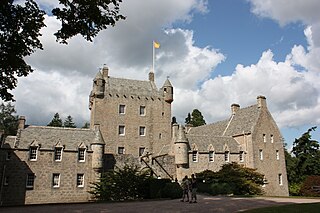
Cawdor Castle is a castle in the parish of Cawdor in Nairnshire, Scotland. It is built around a 15th-century tower house, with substantial additions in later centuries. Originally a property of the Calder family, it passed to the Campbells in the 16th century. It remains in Campbell ownership, and is now home to Angelika Campbell, Dowager Countess Cawdor, stepmother of Colin Campbell, 7th Earl Cawdor.
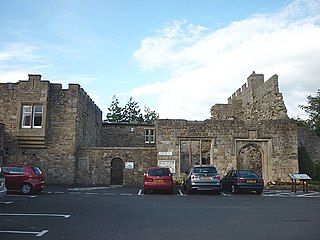
Blenkinsopp Castle is a fire-damaged, partly demolished 19th-century country mansion, incorporating the ruinous remains of a 14th-century tower house, which is located above the Tipalt Burn approximately one mile south of Greenhead, Northumberland, England. It is a Grade II listed building; it is also a Scheduled Ancient Monument as one of the "surviving tower houses retaining significant medieval remains".

Lauriston Castle is a 16th-century tower house with 19th-century extensions overlooking the Firth of Forth, in Edinburgh, Scotland. It lies on Cramond Road South, between Cramond, Davidson's Mains, and Silverknowes. The substantial grounds, Lauriston Castle Gardens, operate as a local park. The castle was bequeathed to the Edinburgh Corporation and hosts the Lord Provost's annual Garden Party. The house is a Category A listed building and the grounds are included in the Inventory of Gardens and Designed Landscapes in Scotland.

Fordell Castle is a restored 16th-century tower house, located 1.25 miles (2.01 km) north-west of Dalgety Bay and 2 miles (3.2 km) east of Dunfermline, in Fife, Scotland. Parts of the castle date from before 1566, though most dates from 1580 or later. The chapel was rebuilt in 1650. The interior of the castle was substantially renovated in the 1960s, with additional major renovations to the castle interiors and chapel in the early 2000s. The estate is in private ownership and not available for public tour.
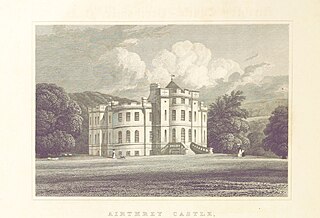
Airthrey Castle is a historic building and estate which now forms part of the buildings and grounds of the University of Stirling in central Scotland. The 18th-century building with 19th-century additions occupies a beautiful setting in landscaped grounds in the southern edge of the Ochil Hills, above the Forth valley. It is located close to Bridge of Allan, two miles from the historic city of Stirling.

Craigiehall is a late-17th-century country house, which until 2015 served as the Headquarters of the British Army in Scotland. It is located close to Cramond, around 9 km (5.6 mi) west of central Edinburgh, Scotland.
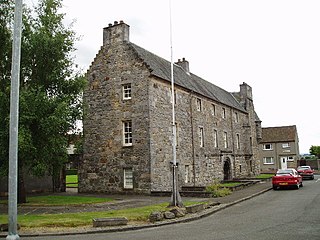
Menstrie Castle is a three-storey manor house in the town of Menstrie, Clackmannanshire, near Stirling, central Scotland. From the early 17th century, it was home to Sir William Alexander, 1st Earl of Stirling, who was instrumental in founding the colony of Nova Scotia. It was later owned by the Holburn or Holborne family, who were created Baronets of Menstrie in 1706. The castle was restored in the 20th century, won a Civic Trust award, and now incorporates holiday accommodation, private flats and museum. The museum previously opened 2 daysa week by the National Trust for Scotland. is now open by request through the Menstrie Community Council.

Craigcrook Castle is a 6,701 square feet (622.5 m2) castle giving its name to the Craigcrook district of Edinburgh, about 3 miles (4.8 km) west of the centre of Edinburgh, Scotland. The castle is primarily of the 17th century, though with later additions. In the 19th century, it was the home of Francis Jeffrey, Lord Jeffrey, and became known for its literary gatherings. It is a category B listed building.

Ayton Castle is located to the east of Ayton in the Scottish Borders. It is 9 kilometres (5.6 mi) north-west of Berwick-upon-Tweed, in the former county of Berwickshire. Built around a medieval tower house, the present castle dates largely from the 19th century. Ayton Castle is the caput of the feudal barony of Ayton. The castle is protected as a category A listed building, and the grounds are included in the Inventory of Gardens and Designed Landscapes in Scotland, the national listing of significant parks and gardens.

Balcarres House lies 1km north of the village of Colinsburgh, in the East Neuk of Fife, in eastern Scotland. It is centred on a mansion built in 1595 by John Lindsay (1552–1598), second son of David, 9th Earl of Crawford. The house became the family seat of the Earl of Crawford. The present house is the result of substantial extensions in the early nineteenth century, using part of a fortune made in India, but preserves much of the original mansion.

Stobo Castle is located at Stobo in the Scottish Borders, in the former county of Peeblesshire. The Manor of Stobo was originally owned by the Balfour family. It became the family seat of the Graham-Montgomery Baronets from 1767. The building of the present castle began in 1805 and was completed in 1811 under the supervision of architects Archibald and James Elliot. It is currently operated as a health spa. The house is protected as a category A listed building, while the grounds are included in the Inventory of Gardens and Designed Landscapes in Scotland, the national listing of significant parks and gardens.
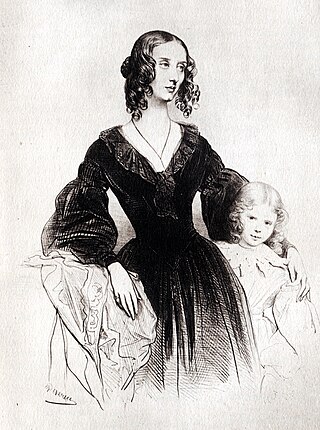
Jean ("Jane") Wilhelmina Stirling was a Scottish amateur pianist who is best known as a student and later friend of Frédéric Chopin, who dedicated Nocturnes, Op. 55 to her. She took him on a tour of England and Scotland in 1848, and took charge of the disposal of his effects and manuscripts after his death in 1849.

Abergeldie Castle is a four-floor tower house in Crathie and Braemar parish, SW Aberdeenshire, Scotland. It stands at an altitude of 840 feet (260 m), on the south bank of the River Dee, five miles (8 km) west of Ballater, and about two miles (3 km) east of the royal residence of Balmoral Castle. Behind it rises Creag nam Ban, a rounded granite hill about 527 metres (1,729 ft) high, and across the river to its front is the cairn-crowned Geallaig Hill, rising to 743 metres (2,438 ft).

Woodleigh Replicas was a park of miniatures situated in the rural community of Burlington outside Kensington, Prince Edward Island on a 30-acre site. The visitor attraction opened in 1957 and closed in May 2008. In 2021 the property was purchased and the new owners began a restoration of the main structure, the Tower of London, as well as Dunvegan Castle. Though no longer intended as a tourist attraction, they are expected to be used for private rentals and events under the brand name Woodleigh Castles.

Ochiltree Castle is a 16th-century tower house a few miles south east of Linlithgow in West Lothian, Scotland. It is also described as a farmhouse and lairds house. Along with its boundary wall, the castle was designated as a Category A listed building in 1971.
Events from the year 1848 in Scotland.
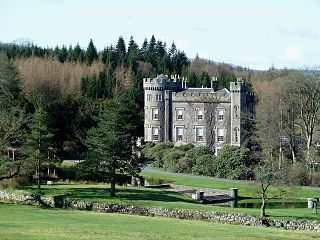
Cloncaird Castle is located near the small village of Kirkmichael, around 6 kilometres (3.7 mi) east of Maybole in South Ayrshire, Scotland. The castle lies beside the Kelsie Burn, at the centre of a 140 acres (57 ha) estate. Originally a 16th-century castle, it was extended and rebuilt as a country house in the early 19th century. After a time as a convalescent home, it is now a private residence once more.



















